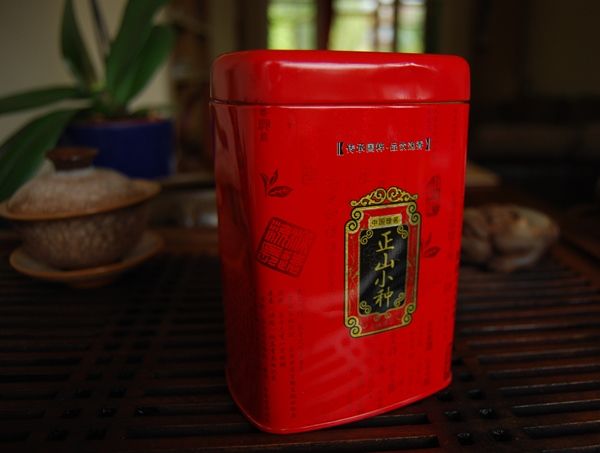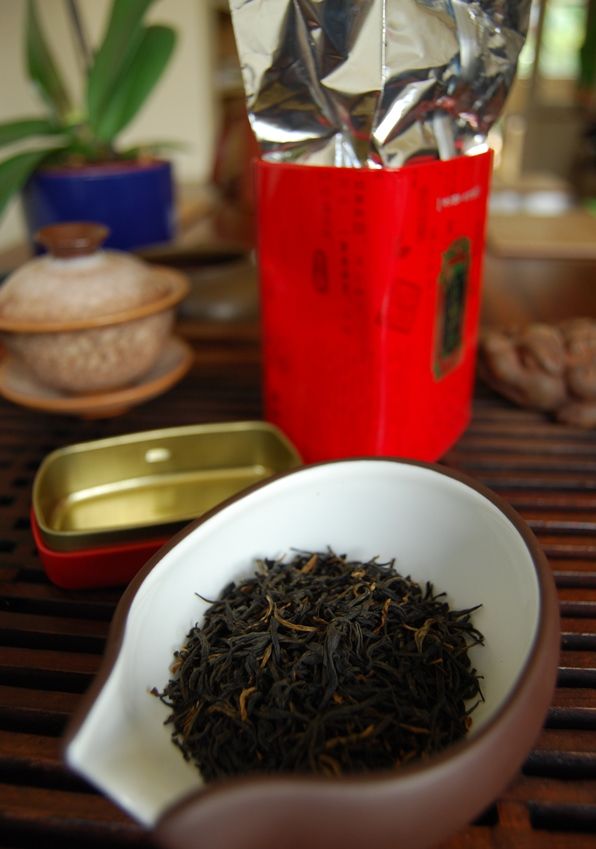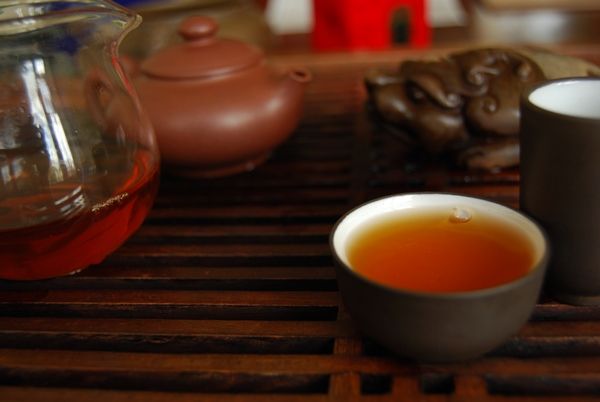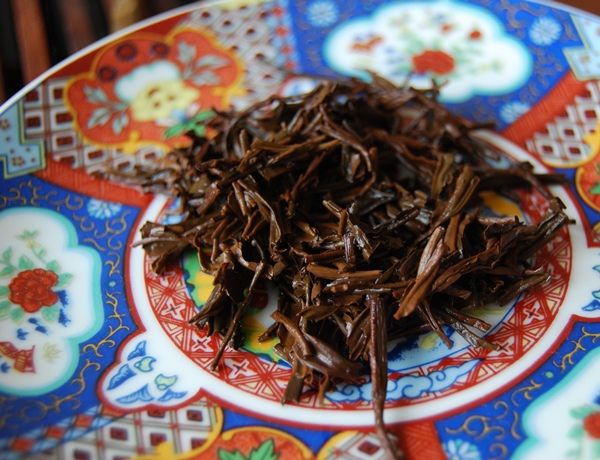Regular readers may remember my eternal, unfulfilled quest to find a solid Lapsang Souchong. I have come very close; the delicious 2010 Zhengshan Xiaozhong from Essence of Tea was a marvellous hongcha, full of elegance and beauty - but it wasn't quite an Englishman's lapsang. Likewise, I was sent a charming version from Canton Tea, which has perhaps been the closest to what I'm after, despite its rather excruciating price.
My long-time Singaporean teachum, Keng, took pity on us, miserable offenders, and sent a few different types of lapsang with his last package.
The tin contains a sealed, foil bag, which is home to a tippy, blank hongcha that has a satisfyingly grape-like scent.
When brewed, it becomes pure, liquid pine. It really is rather pine-like. As I'm sure you know, lapsang souchong is made by smoking the leaves in pinesmoke. It traditionally comes from Xingcun [hshing-tsun] village of Chongan county, in northern Fujian.
It is full of charms, and has a dense, rich body. In my diary, I wrote "smooth, long, and satisfying". The hongcha base is excellent, and it reminds me very much of the 2010 Essence of Tea version. This, like the latter, is a classically beautiful tea. My wife comments, "Very fragrant - excellent hongcha".
I appreciate that showing photographs of a tea of which I have no idea where to buy more may be less than ideal. Even less ideal, then, will be the statement that Keng also provided a tub of lapsang from a local teashop called "Tea Chapter", and this latter is actual Englishman's lapsang - it is properly smokey, and less delicate, than these other fine hongcha.
So, in a way, my search is over. Thanks to Keng, the tub of "Tea Chapter" lapsang (not shown here) is my perfect way to unwind if the mood for such a tea takes me. That said, both this delicious red tin of lapsang, and Essence of Tea's 2010 and 2011 versions (more on the latter later) are working on my affections: they really are too good not to consider. They are more delicate, and more like hongcha, than Englishman's lapsang, but they are remarkable.
Thanks again to Keng for the fantastic selection. Lei and I have enjoyed these very much; lapsang is, coincidentally, one of her favourites, too.





Might I ask, how do you define a proper Englishman's lapsong souchong? Is it the smokiness? The strong body? The complexity (or lack thereof)?
ReplyDeleteI'm only a poor American, so I must learn from my betters.
Cheers,
Steven
(The 39 Steeps guy)
By the way, I just wrote a bit about your post over at my blog. Thank you, as always, for providing such a lovely essay for me to contemplate this morning.
ReplyDeleteHobbes,
ReplyDeleteMay I ask how you brew your Lapsang?
Dear Stephen,
ReplyDeleteWhat a lovely article, thank you! I see that you found my approximate definition of the lapsang for which I'm searching. :)
Dear Drumhum,
I brew lapsang like any other hongcha: in my little hongcha put, with a lot of leaves, water-in/water-out infusions. In fact, this is the way that I brew all tea, because I am a simple man!
Toodlepip,
Hobbes
Hi, I am so glad the "Tea Chapter" lapsang is what you are looking for! It's slightly costlier than the red tin's lapsang as Tea Chapter caters to tourist, while the red tin is from Chinatown, S'pore (cater to both tourists and local). When I back from overseas in a few weeks time, I will take some pictures of the 2 tea shops for your reader's reference. Cheers! Keng.
ReplyDeleteDear Keng,
ReplyDeleteThat would be great to see - thank you! Thanks again for the lovely lapsang varieties, which are a palpable hit with both Lei and me. Actually, Xiaohu rather enjoys it, too. :)
Toodlepip,
Hobbes
Hello Hobbes,
ReplyDeleteI just finished up a 100g bag of "Golden Eyebrow Lapsang Souchong Black Tea" from jkteashop.com, where it was not inexpensive when I bought it, and is outrageous now. This was a fabulous hongcha, made with only the finest tips, but as you note about other fine Lapsang Souchong (LS), not the earthy smokey stuff familiarity draws you back to. I can empathize. I am about to order some "cheap and cheerful" LS from devotea.com, a Canadian outfit with a good assortment of "British" style teas from Ceylon and Darjeeling, albeit their LS is from Fujian, and I suspect it will fill the bill, if it's not awful. Anyway, devotea's excellent description of the Indian Tea grading system claims that "souchong" means "the larger leaves picked from closer to the bottom of the branch". I have read elsewhere (sorry, can't find it) that the entire name "Lapsang Souchong" is a corruption of the Chinese name of the place of origin of this tea. Any thoughts?
-Carla
Dear Carla,
ReplyDeleteI am completely in the mood for some decent Ceylon, and Darjeeling, and therefore intend to check out (the admittedly dreadfully-named) devotea.com at your suggestion! Many thanks!
I'm likewise of the impression that the xiaozhong are the basis leaves from the branch. Lapsang is supposed to be brutal - this trend towards eensy-weensy, delicate "zhengshan xiaozhong" is all well and good, but I needs me my hardcore (British style) lapsang. :)
Toodlepip,
Hobbes
Hobbes,
ReplyDeleteThe shipment from devotea.com arrived today. Looking at the return address, I must correct myself; they're from "Little Canada" Minnesota. I must have scanned that briefly while on their site and thought they were Canadian. Oops. I'm drinking the LS right now. The pine smoke, which brutally assaults the nose when one opens the bag, is still quite apparent in the cup, though not as abusive. I can see why many people consider this a crass cup of tea, and it's true that the tea itself is in the background here; nevertheless, I'm rather enjoying it.
Now we're talking. :)
ReplyDelete